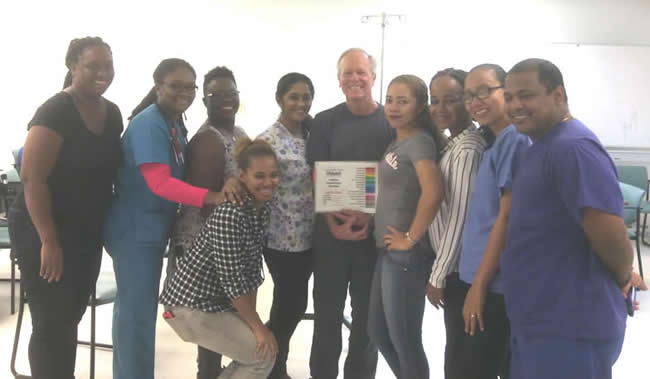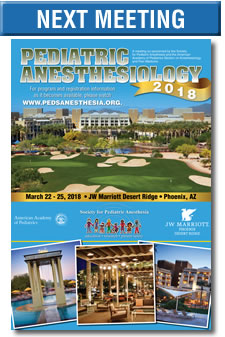SPACIES
Volunteering to Support Resident Education in Guyana
By Mark Singleton, MD
University of California, San Francisco
I must admit that when I decided to spend three weeks of April of this past year in Guyana, after learning about a volunteer teaching opportunity through the ASA Committee on Global Humanitarian Outreach, I knew little of the country. The only lasting connection that I, and many fellow San Franciscans would forever have with Guyana was the 1978 mass murder-suicide of members of Jim Jones People’s Temple and its terrorizing effect on our city, which occurred when I was a UCSF medical student.
In the nearly forty years that have passed since those tragic events, Guyana has receded into relative obscurity as the only English speaking South American country; but connected more through culture and identity with the Caribbean islands, and even to India, where the majority of its citizens trace their ancestry from British colonials. I have now had the good fortune to rediscover Guyana, its unique culture, history and people and to have participated a little in beginnings of their robust, locally grown, anesthesiology residency training program.
Project Dawn, a facility that houses visiting health professionals who come to the Georgetown Public Hospital to volunteer in teaching or direct care, is a remarkable facility. Sister Mary Carmen Gannon, a Baltimore native, catholic nun, registered nurse, and later physician, who spent many years and received many accolades working in Guyana, founded this center.
Situated several miles from the “in town” location of the Hospital, from the outside it appears to be a warehouse building behind a security fence and entry guard. The upper floor is a comfortable and spacious dormitory that includes about a dozen private rooms with baths and a large communal kitchen and living room space. There is an on-property caretaker and a coffee roasting business in an adjacent building with produces excellent export coffee that can be purchased from the owner. The ground floor of Project Dawn (which stands for Donors and Workers Now) is occupied by the local EMS system dispatch and ambulance staff who appear to be there at all times, a former clinic, and classrooms with mannequins and props for training simulation. Healthcare students and trainees of various sorts are often taking exams in the facility.
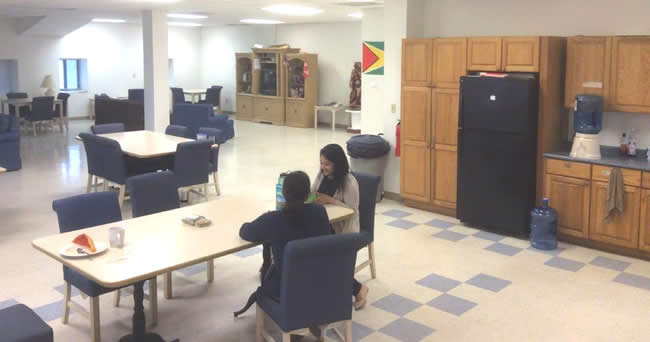
Image 1: KITCHEN AND LIVING ROOM AREA OF PROJECT DAWN GUEST RESIDENCE
The Georgetown Public Hospital complex takes up one city block and the Mother Baby section across the street another half block. The ORs and ICU are located on the second floor. A wide variety of surgical procedures are performed, including total joint replacements, neurosurgery including craniotomy, laparoscopy, thoracic, and pediatric surgery. Visiting teams from abroad come periodically to perform open-heart surgeries including pediatric congenital cases, and are essentially self-contained, except for post surgical care especially for the last cases of the visit. There are six operating rooms including a dedicated eye surgery room that was mainly used for cases performed under topical or local anesthesia only. Neither labor epidurals nor post-surgical epidurals for analgesia, are done because of the lack of logistical ability to manage them. The OR, and hospital generally, was surprisingly well supplied for a public hospital in a developing national capital. Abundant amounts of equipment, medication, IV supplies, and a variety of disposables were evident throughout.
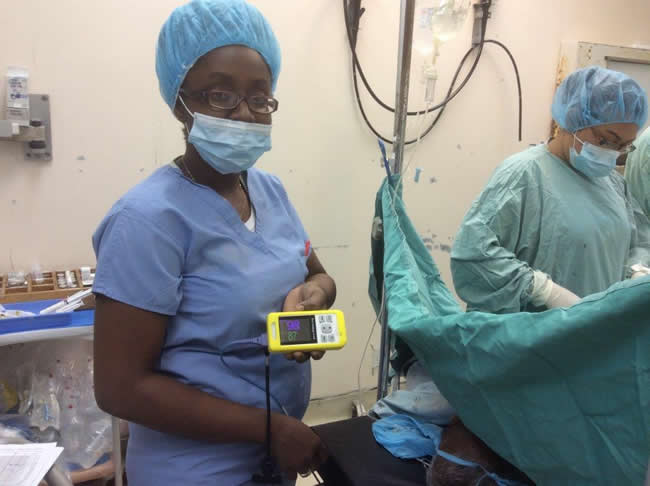
Image 2: GPH NURSE ANESTHETIST USING LIFEBOX DONATED PULSE OXIMETER IN THE OR
It is quickly apparent that there are many opportunities for improvement. Attention to hand washing is nonexistent, except of course for formal pre-surgical scrubbing. In the OR, breaches of sterile technique are commonplace, and procedures addressing post surgical infections and removal of compromised hardware were frequent. Pre-surgical time-outs are meticulously performed but are conducted by the circulating nurse going around the room checking off various elements rather than as an all-inclusive conversation with the entire team participating openly. From my observations and the comments of the residents with whom I worked, PACU nurses provide the bare minimum direct patient care and monitoring, so the assurance of the well being of recovering patients falls entirely to the anesthesiologists. Everywhere everyone is constantly texting, viewing or talking on cell phones. I never saw a patient’s temperature measured.
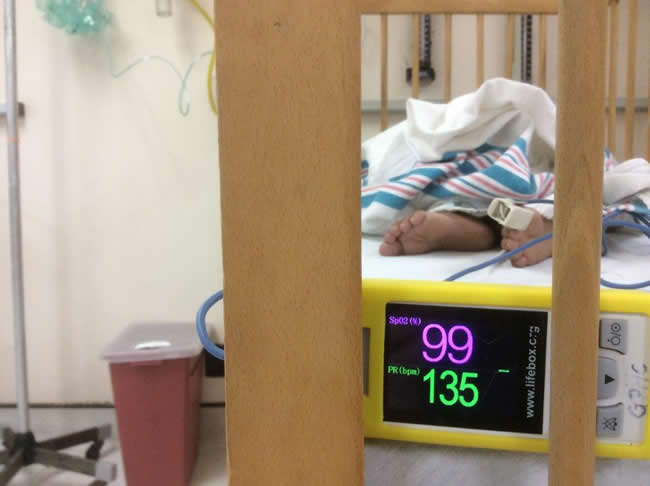
Image 3: LIFEBOX DONATED PULSE OXIMETER IN USE IN THE GPH RECOVERY ROOM
The Anesthesia Department consists of staff consultants/faculty, anesthesiology residents, and nurse anesthetists. I met and interacted with eight staff (including one visiting for one year from China) and nine residents, two of whom were seniors in their final months of training and preparing for examinations. My daily routine was to spend the morning and early afternoon in the OR more or less as a collegial observer, but also assisting with clinical patient care and teaching whenever appropriate. All cases had assigned staff and resident and/or nurse anesthetist, so I was at liberty and felt welcome to insert myself wherever I wished. Since it was made clear to me that they wished me to focus on pediatric anesthesia, I sought out pediatric cases, especially the Monday room block set aside for elective pediatric surgery. Everyone was extremely welcoming including the nurses and surgeons.
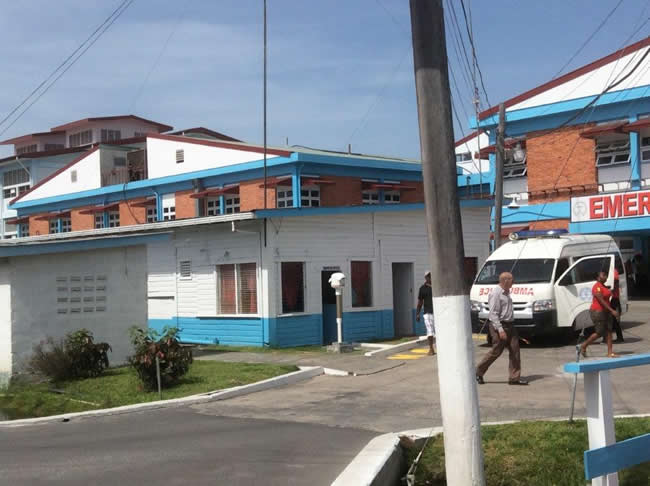
Image 4: GEORGETOWN PUBLIC HOSPITAL (GPH) 2ND FLOOR OPERATING ROOM WINDOWS
As one might anticipate there are some limitations on the local practice that lead to differences from what might be expected at a hospital in the USA. Although laparoscopic surgeries are performed, these can be complicated by equipment problems. Open cholecystectomy for common bile duct exploration is routine due to lack of fluoroscopy to perform cholangiography. One orthopedic surgeon explained to me that because fluoroscopy was unavailable more open procedures are performed for direct visualization. Open pyelolithotomy is also common because lithotripsy is available only in private hospital or clinic settings. Many of these cases would benefit from epidural analgesia but it is not performed because the ward management cannot be guaranteed safe. The residents recognize this deficiency. I did have the opportunity to demonstrate and supervise several simple pediatric caudal blocks, which were first time events for the trainees and attendings as well.
The educational administration of the anesthesiology residency is under the direction of Dr. Alexandra Harvey. She supplied me with an outline of topics to cover related to pediatric anesthesiology just prior to my travel, and also requested that I conduct a PALS course for the all the residents during the third week that I was there. During the first two weeks of my visit I met in the afternoons several times each week with the two senior residents, Drs. Youlanda Hendricks and Onica Higgins, for lecture/discussions on topics. I brought with me Fritz Berry’s textbook Pediatrics for the Anesthesiologist that I used as a basis for these talks and donated to the Dept at the end of my visit. I also used the electronically formatted syllabus from the 2013 SPA Intensive Review of Pediatric Anesthesia Course, which I had downloaded to my iPad when I took the course. This extensive collection of slides was so useful to Dr Hendricks and Higgins that they asked me if they could get access to the materials. I emailed Stewart Hinckley at the SPA with this request, and he was able to get approval from SPA leadership to allow special online access to the latest version of this course material for not only the two senior residents, but also the entire resident group. It was extremely gratifying to me personally to be able to obtain this gratis (usually quite expensive) for their continuing studies, and I know there is enormous gratitude from all the Guyanese anesthesiology residents for this generous gift from SPA.
I also took with me four PALS course books and a number of folding algorithm charts that I had at home from courses I took myself in the recent past, which I distributed to the residents. During my third week I spent two afternoons with all the residents engaged in our (unauthorized but essentially complete) PALS course, which included didactic review and discussion of respiratory and cardiac pathophysiology, shock, trauma, pharmacology, ECG interpretation, cardioversion and defibrillation. These classes were conducted at the Project Dawn facilities downstairs. The final session was devoted to scenarios with mannequins, a functional AED training device, intra-osseous vascular access, and all the other props you might wish to have. Afterward I took the group for farewell pizza dinner at the nearby mall. I also presented the Department with a laminated Pedi Crisis Manual that I had downloaded from the SPA website and printed before I left home. (pictured below)
It was a great pleasure and privilege for me to spend this time with such a fine group of dedicated and smart young anesthesiologists who promise a strong future for the specialty in Guyana, a beautiful and unique country. ASA members are welcome to apply for this opportunity through the Global Humanitarian Outreach Committee linkage, http://www.asahq.org/GHO.
